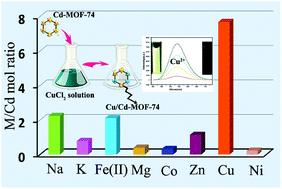A luminescent metal organic framework with high sensitivity for detecting and removing copper ions from simulated biological fluids†
Abstract
The crystal structure of Cd-MOF-74 was obtained for the first time that possesses high sensitivity for the detection of copper ions from water and simulated biological fluids based on changes in luminescent intensity. Furthermore, Cd-MOF-74 could selectively remove Cu2+ from simulated biological fluids that contain Mg2+, Co2+, Zn2+, Fe2+, Ni2+, Na+, and K+. The adsorption capacity of this adsorbent for copper ions reached 189.5 mg g−1 and it quickly adsorbed copper ions within 10 minutes under 10 ppm Cu2+ in the simulated biological system. XPS, PXRD, and gas adsorption measurements revealed that this high sensitivity and selectivity of Cd-MOF-74 resulted from the partial substitution of Cd2+ by Cu2+ in the framework. Although many MOF materials have been employed for sensor or selective adsorption of Cu2+, Cd-MOF-74 is the first example of MOFs showing both capabilities in simulated biological fluids, which represents a pioneering work that extends the applications of MOF materials in the biological field.



 Please wait while we load your content...
Please wait while we load your content...